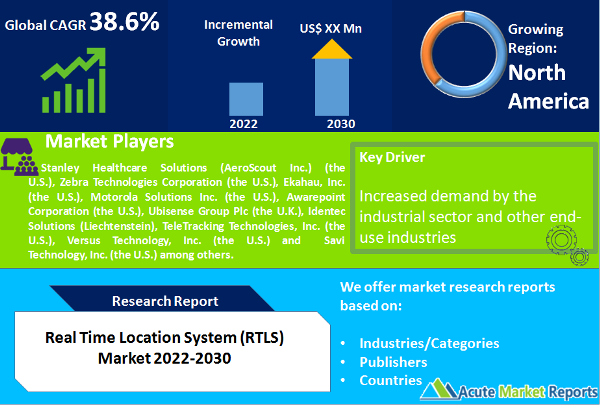
This report analyzes the global real time location system (RTLS) market in terms of technology, end-use vertical, and geography. On the basis of end-use vertical, the global market for real time location system is segmented into healthcare, transportation and logistics, industrial manufacturing and processing, government, hospitality, retail, and others (education, etc.). Similarly, on the basis of technology, the global real time location system (RTLS) market is further classified into RFID, Wi-Fi, ZigBee and UWB (Ultra-wideband), ultrasound, infrared, and others (Hybrid Technologies, GPS, etc.). The geographical distribution of the global real time location system market considered in this study encompasses regional markets such as North America, Europe, Asia Pacific, Middle East and Africa, and Latin America.

The mounting pressure on businesses to achieve operational efficiencies, sustain profit margins, and enhance customer satisfaction in order to ensure healthy market position have collectively triggered demand for real time location systems across multiple industry verticals. The ability of RTLS solutions to track assets and solve other wide range of operational issues in real-time makes them an integral component of business processes. Furthermore, government initiatives and heavy investments in the RTLS technology are collectively favoring the market growth, especially in developed economies. These factors are expected to contribute towards a compounded annual growth rate (CAGR) of 38.6% during the forecast period 2025 – 2033. However, lack of interoperability between various technology infrastructures coupled with the lack of awareness regarding the benefits offered have hampered the swift growth of real time location system market across the globe.
Real Time Location Systems have become an integral component in today’s businesses that are required to achieve operational efficiencies, sustain profit margins, and enhance customer satisfaction in order to remain competitive in the market. In addition, today’s sophisticated business models where customers are demanding and workforce is more mobile have further necessitated demand for real time location systems in varied verticals.
The healthcare segment dominated the global real time location system market in base year 2021. The segment accounted for over 40% of the global real time location system market revenue in the same year. The trend shall prolong and the segment is presumed to witness steady growth on account of controlled growth in patient monitoring and asset tracking applications. Majority of the healthcare facilities deploy Wi-Fi-based RTLS solutions to locate the position of several assets within the campus.
In terms of technology, the RFID (Radio Frequency Identification) segment led the global real time location system market in base year 2021. The segment accounted for over 38 percent of the global real time location system market revenue in the same year. However, other technologies including Wi-Fi, ZigBee and UWB are presumed to witness greater adoption than RFID technology during the forecast period. ZigBee and UWB technologies help industrial manufacturers to improve efficiency of their everyday operations, thereby reducing the operational cost to a great degree. Thus, these technologies are expected to witness maximum adoption across industrial manufacturing and processing industries. On the other hand, Wi-Fi based real time location systems are presumed to witness steady growth since these solutions eliminate the need for a proprietary wireless infrastructure, thereby improving payback.
North America comprising Canada and the U.S. is currently the largest real time location system market. The region accounted for over 35% of the global market revenue in base year 2021. The market for real time location systems in North America is majorly driven by strong demand from the healthcare sector. The presence of sophisticated healthcare infrastructure has been instrumental in driving uptake of real time location systems for medical applications. Overall higher acceptance to technology has ensured greater adoption in North America. The trend is expected to continue and the region is presumed to hold on to its leading position throughout the forecast period 2025 – 2033. However, Asia Pacific is expected to witness maximum growth during the forecast period 2025 – 2033 led by growing adoption in varied industry verticals across Chinese and Indian markets.
Historical & Forecast Period
This study report represents analysis of each segment from 2023 to 2033 considering 2024 as the base year. Compounded Annual Growth Rate (CAGR) for each of the respective segments estimated for the forecast period of 2025 to 2033.
The current report comprises of quantitative market estimations for each micro market for every geographical region and qualitative market analysis such as micro and macro environment analysis, market trends, competitive intelligence, segment analysis, porters five force model, top winning strategies, top investment markets, emerging trends and technological analysis, case studies, strategic conclusions and recommendations and other key market insights.
Research Methodology
The complete research study was conducted in three phases, namely: secondary research, primary research, and expert panel review. key data point that enables the estimation of Real Time Location System (RTLS) market are as follows:
Market forecast was performed through proprietary software that analyzes various qualitative and quantitative factors. Growth rate and CAGR were estimated through intensive secondary and primary research. Data triangulation across various data points provides accuracy across various analyzed market segments in the report. Application of both top down and bottom-up approach for validation of market estimation assures logical, methodical and mathematical consistency of the quantitative data.
| ATTRIBUTE | DETAILS |
|---|---|
| Research Period | 2023-2033 |
| Base Year | 2024 |
| Forecast Period | 2025-2033 |
| Historical Year | 2023 |
| Unit | USD Billion |
| Segmentation | |
Technology
| |
End-use Application
| |
|
Region Segment (2023-2033; US$ Billion)
|
Key questions answered in this report